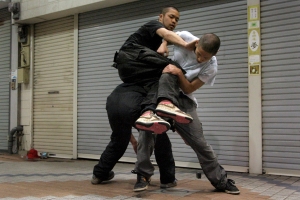
Video still of contact Gonzo from the 2008 performance “We're Gonna Go Dancing!! Vol. 9” at Beppu City Center, Oita; Toda Yoichi Photo/Courtesy of Mori Art Museum
I look forward to the triennial “Roppongi Crossing” exhibitions as a chance to see what the leading curators and critics in Japan are doing to present Japanese contemporary art in an international context. This year the show was not only drastically reduced in number, but contained a number of puzzling choices that made for a disjointed experience.
Include rabble rousers Chim | Pom in the show but seal them off behind glass as if they were dangerous to encounter in person? I thought that was their point — that art should get in you face. The six should have been given a whole room to desecrate so that viewers would have to stumble through the mess they left behind.
Rogue Gallery’s powerful sound and video installation of performances produced through recording night cruises in their Citroen is shut off behind sound-proofed doors you could easily walk past? How many people missed the chance to be mesmerized by flashing tailights and a throbbing motor? I think I would have greated people at the front door with this aural onslaught to let them know things were different around here.
contact Gonzo squeezed in next to Ujino so that it was hard to tell where one started and the other ended?
One last thought — the Japanese art market continues to struggle despite the great level of creativity here. I love installation art that creates immersive experiences, but the reality is in an underdeveloped market, 2D will still be king among the collectors that exist. At the yearly survey of 2D art held at the Ueno Royal Museum, “Visions of Contemporary Art,” it is always entertaining to see the breadth of taste among the 40 some curators, critics and professors who each pick one artist to join. But the result is inevitably disjointed and kind of a let down. What if the Mori had used its curatorial muscle to taken on 2D art in “Roppongi Crossing” — creating a “Best of painting/photography/new media in 2D” exhibition? What better way to find a way to seriously engage with the kind of work that you find in the best of Japanese galleries?
My publicly sanctioned account is here: “‘Roppongi Crossing’ may be better when crowded”

